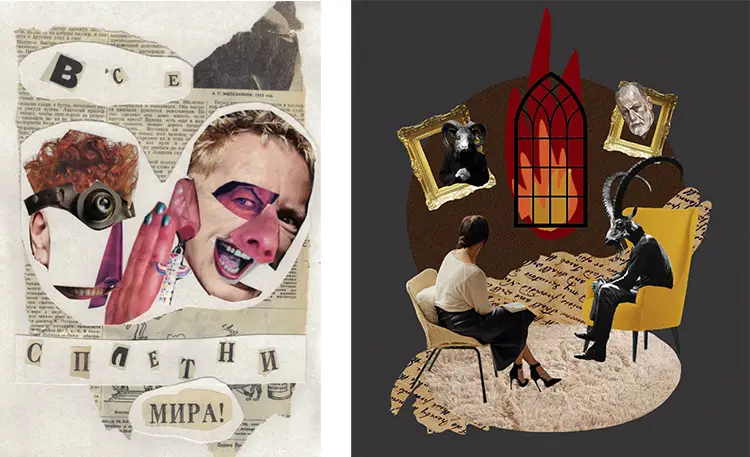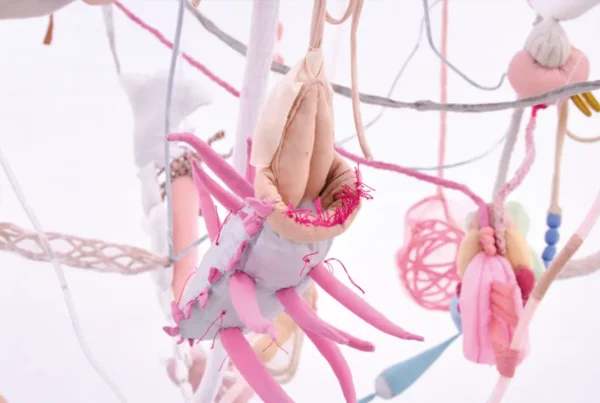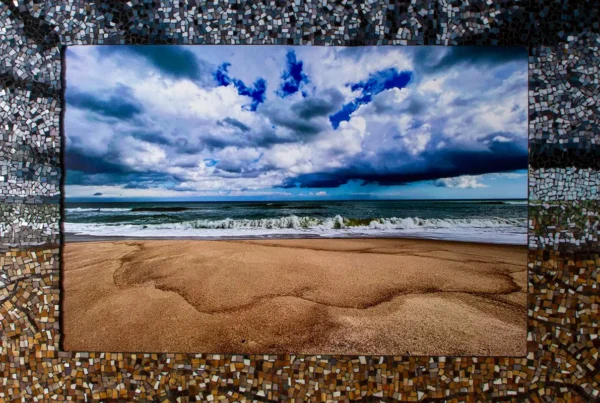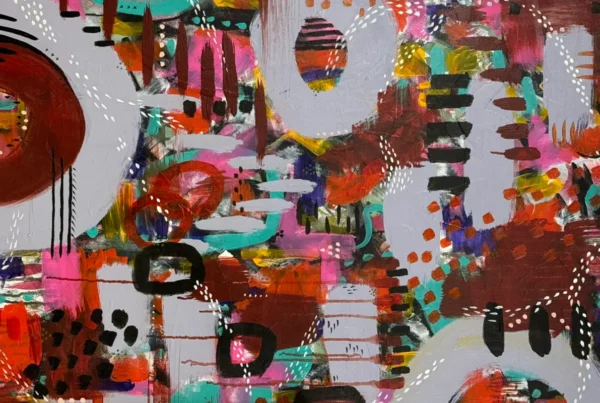“I try to collect fragments of that broken world and rebuild them into something alive, something that still believes in emotion and meaning.”
A Fragile Order: Between Chaos, Poetry, and Truth
Valerie Deleon stands at the edge of contemporary collage, where emotional intensity and visual critique intertwine through fragments of forgotten media and resonant memory. Her practice emerges not from academic intent, but from a deeply personal urge to rebuild meaning from broken images. At the core of her method is the belief that collage is more than an art form; it is a mode of perception. Deleon grew up immersed in a post-Soviet visual culture, where contradictory aesthetics collided daily—rigid systems coexisted with absurdity, and official propaganda shared space with poignant poetry. This visual tension profoundly shaped how she processes and reinterprets imagery, prompting her to question surface narratives and uncover layered truths.
Rather than aiming for pristine composition or digital sleekness, Deleon seeks life within imperfection. She gathers old newspapers, photographs, textures, and memory-laden scraps, not as static relics, but as living components waiting to speak again. These pieces often arrive to her studio in disarray, lingering in piles for weeks or months until a moment of clarity emerges. The process is neither linear nor logical. Instead, it mimics the rhythm of human memory: non-sequential, emotive, sometimes abrupt. Her artworks carry this instability intentionally, drawing the viewer into a shifting emotional space. They suggest that meaning can be neither fixed nor fully known, but can still be felt in the act of assembly.
There is a vulnerability in Deleon’s approach that sets her apart in a digital era often focused on immediacy and polish. Her collages are handmade, tactile, and intimate, resisting both perfection and permanence. She often leaves gaps, rips, and exposed layers—inviting viewers to complete the image with their own projections. In her view, fragments are not failures; they are evidence of survival. Every torn edge or recontextualized phrase becomes part of a larger question: how can one still believe in beauty, sincerity, or connection amid cynicism and overstimulation? Her works answer not with resolution, but with a quiet insistence on emotional presence.

Valerie Deleon: Between Irony and Tenderness
Deleon’s entry into the art world was not mapped out by formal training or childhood aspirations. She began cutting images as a way to articulate feelings that language could not contain. That instinctive act soon evolved into a compelling practice, where visual fragments allowed her to move through contrasting emotional states—sincerity and satire, pain and romance, critique and longing. This balance remains central to her work today. She creates a visual terrain where Soviet design logic merges with pop absurdity, and where melancholic undercurrents coexist with biting cultural commentary. It is this tension—between reverence and rebellion—that defines the emotional architecture of her art.
Her collages resist simple categorization. They are part protest, part poem. Recurring motifs such as voyeuristic gazes, disembodied limbs, childlike crowns, handwritten fragments, and planetary symbols function as visual metaphors for deeper human concerns. Themes of isolation, love, truth, and resistance echo throughout her work, not as declarations, but as open-ended reflections. Deleon invites the viewer to witness the fragile spaces where clarity collides with chaos. The quiet power of her art lies in its emotional ambiguity: a gesture might suggest both embrace and withdrawal, a phrase might hint at both irony and yearning. These contradictions are not resolved but allowed to coexist, mirroring the complexity of inner life.
Rather than retreating into nostalgia, Deleon reclaims historical aesthetics to address contemporary dilemmas. Soviet graphic cues, for example, are not romanticized but recontextualized—used to question modern systems of control, disinformation, and emotional desensitization. Her style retains a sense of romanticism, yet always keeps one eye on the political. This duality allows her work to resonate on multiple levels. One can appreciate the visual beauty of her compositions, while also recognizing the critique embedded within. In this way, Deleon does not offer escape; she offers confrontation with the poetic and painful truths embedded in our collective visual consciousness.

Fragments of a Digital Pulse: Influence, Media, and Emotional Archives
Deleon draws inspiration from a complex web of sources, with early Soviet avant-garde artists like Rodchenko, Lissitzky, and Klutsis providing conceptual backbone. Their influence is less about stylistic imitation and more about their daring to envision new visual systems. What captivates Deleon is their belief in art’s transformative potential—their willingness to invent in response to rupture. That same impulse drives her, though her focus is not on utopian reinvention but on emotional survival. In an era defined by overstimulation and algorithmic communication, she sees collage as a way to carve intimacy out of chaos. Her work becomes a counter-narrative to the noise of digital culture, offering spaces for slowness, reflection, and tenderness.
Her influences, however, are not limited to canonical artists or historical movements. The raw materials of her daily experience—social media syntax, broken relationships, the rhythm of news cycles—feed directly into her visual language. The barrage of fragmented communication becomes both subject and material. In this way, her practice mimics a kind of emotional archaeology, excavating moments of human feeling from within the ruins of cultural repetition. She refers to this process as a dialogue with the overstimulated world, a back-and-forth between self and screen, memory and noise. The result is a collage not only of images, but of affective states: longing, irony, fear, and the fragile hope of connection.
Deleon also treats the act of collecting as deeply intuitive. Her studio is filled with fragments—newspapers, textures, magazine cutouts, letters, faces—that accumulate over time without predetermined purpose. Each element waits to be chosen, often sitting for weeks until a narrative thread becomes visible. This method of waiting and listening allows her to bypass rational composition and instead follow emotional resonance. Her upcoming project, “Echoes of Tender Protest,” seeks to expand this process into the moving image. By combining collage with video, she explores how ephemeral emotion and tactile fragility can survive in digital motion. It is a continuation of her core question: how can love and resistance occupy the same breath?

Valerie Deleon: Vulnerability as a Stage for Truth
Among Deleon’s body of work, the piece titled “Главное — любовь” (“The Main Thing — Love”) holds a distinct emotional weight. It exemplifies her belief that fragility can serve as a site of resistance. At first glance, the piece appears tender—centered on a figure embracing itself, surrounded by torn text and layered textures. However, the image carries a quiet tragedy, suggesting a more complex emotional interior. The text elements, composed of archival newspaper snippets and personal notes, create a fractured narrative that resists neat interpretation. The visual composition becomes a site where memory, language, and self-reflection collide in intimate disarray.
What makes this work particularly resonant is its structure, which Deleon compares to a miniature theatrical stage. Here, the solitary figure performs not for an audience, but for the self. The embrace suggests comfort, but also isolation. The incomplete phrase after “Главное” invites the viewer into an unfinished sentence—a blank space that must be filled not by the artist, but by the observer. For Deleon, that empty dash represents where love exists: in the gap between expression and silence, self and other, hope and hurt. The decision to leave the phrase open-ended transforms the piece from a statement into a question, challenging the viewer to confront their own definitions of love and loss.
The medium of paper collage plays a central role in the work’s emotional impact. Unlike digital compositions, the textures and layers are physically torn, touched, and arranged by hand. This tactility grounds the piece in vulnerability, reinforcing Deleon’s belief that emotional exposure is a form of strength. The analog materials are not aesthetic choices alone, but political and poetic tools—used to affirm the value of imperfection in a world increasingly sanitized by automation. In “The Main Thing — Love,” Deleon demonstrates how an artwork can be both quiet and subversive, both delicate and defiant. It is not only a portrait of self-embrace, but a manifesto of emotional resistance in an age that often demands numbness.








